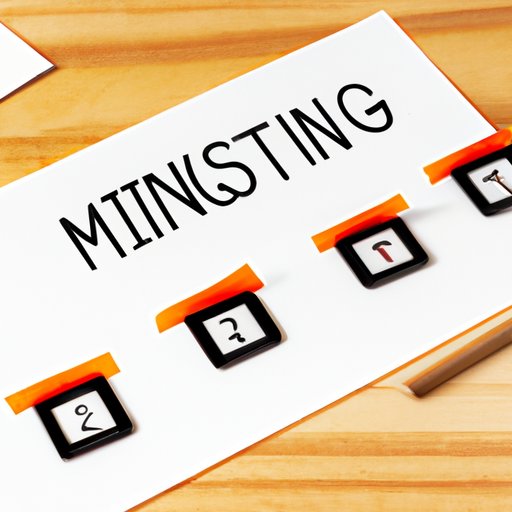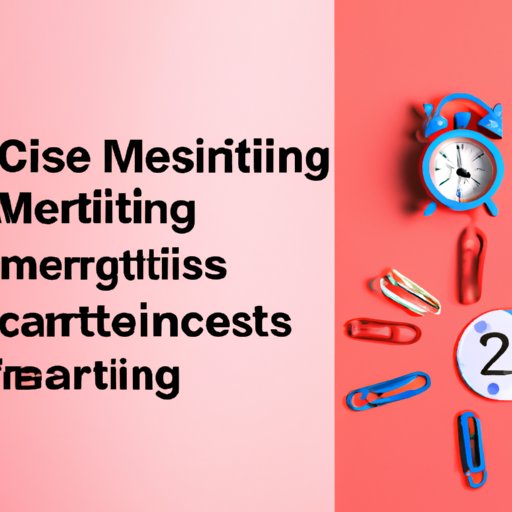
I. Introduction
Meeting minutes are essential records of what has been discussed or agreed upon during a business or organizational meeting. They serve as a documentation of decisions made, goals set, and the direction of the organization. Therefore, it is crucial to ensure that effective minutes are taken to avoid unnecessary misunderstandings, disputes, and unclear expectations.
In this article, we will provide a comprehensive guide to taking meeting minutes. We will cover the dos and don’ts, tips, and strategies for streamlining and maximizing the impact of your meeting minutes.
II. 7 Step Guide to Mastering Meeting Minutes
The following seven steps will guide you in taking meeting minutes:
- Identify the purpose of the meeting.
- Create an outline of the meeting agenda.
- Record attendees names – who was present, and their role in the organization.
- Note any decisions or actions taken during the meeting.
- Record any votes and the outcome.
- Summarize the discussion points raised and identify any areas of disagreement or consensus.
- Conclude with clear next action steps and who is responsible for each action.
Each of these steps is essential in ensuring that you capture all the relevant information during a meeting. For example, identifying attendees and their roles helps to provide context and accountability.
Using clear, concise terminology, avoids ambiguity, and helps to accurately capture decisions, action items, and discussions points. When possible, use digital tools like Google Docs, Zoom, or note-taking apps to streamline your notetaking.

III. How to Create Concise and Effective Meeting Minutes
Effective meeting minutes are clear, concise, and easy to understand. Here are some tips on how to make your meeting minutes concise and effective:
- Use a consistent and easy-to-read format throughout the minutes.
- Be concise. Avoid using unnecessary words or irrelevant details.
- Identify relevant actions and decisions made during the meeting.
- Summarize any essential discussion points raised during the meeting without adding your opinion.
- Avoid jargon or technical terms that might not be understood by everyone.
When creating your meeting minutes, remember that they serve as a legal record of your organization’s decisions. You must remain impartial and avoid adding your opinions or interpretation.
Here is an example of effective meeting minutes:
Meeting minutes: Quarterly Board Meeting
Date: 06/10/2021 Location: Zoom call Attendees: 1. Mr. John (Chairman) 2. Mrs. Jane (Secretary) 3. Mr. William (Treasurer) 4. Ms. Julie (Member) Agenda: 1. Approval of the previous meeting minutes 2. Financial review 3. Election of new committee member 4. Any other business Discussion and Actions: - The minutes of the previous meeting was reviewed and approved. - The treasurer reported a cash balance of $250,000. - Mr. Smith was elected into the committee to replace the outgoing member. - The board decided to establish a new fundraising committee to explore more fundraising opportunities. Next meeting: - The next quarterly board meeting will be held on September 10th, 2021. Respectfully submitted, Jane – Secretary
IV. The Dos and Don’ts of Taking Meeting Minutes
To ensure accurate and effective meeting minutes, avoid these common mistakes:
- Don’t include personal opinions or interpretations.
- Don’t include too many details or irrelevant information.
- Don’t use offensive or derogatory language.
- Do ensure that your minutes are straightforward and easy to understand.
- Do use proper grammar and spelling.
- Do use consistent formatting and terms throughout your minutes.
- Do ensure that you record decisions and any action items agreed upon during the meeting.
Remember, your meeting minutes are essential records that must accurately reflect what occurred during a meeting. Therefore, always remain professional and impartial.
Here is an example of a simple yet effective meeting minute:
Meeting Minutes: Monthly Team Meeting
Date: 01/10/2021 Location: Conference Room Attendees: 1. Mr. John 2. Ms. Julie 3. Mr. Liam 4. Ms. Gail 5. Mr. William Agenda: 1. Reviewing progress report for the month of December 2. Upcoming Projects and Action Plan 3. Team bonding Activities Discussion and Actions: - Team lead presented the progress report of December, which was followed by individual team members discussing their respective goals that were achieved and the obstacles they faced. - The action plan for the upcoming project was discussed, highlighting the responsibilities of each team member - After the discussion, the team bonding activity for the next month was decided to be a volunteer activity at a local charity. Next Meeting: - The next team meeting will be held on February 5th, 2021. Respectfully submitted, John – Team Leader
V. Maximizing the Impact of Meeting Minutes: A Comprehensive Guide
It is crucial to ensure that your meeting minutes have a significant impact. Here are a few ways to achieve this:
- Distribute your meeting minutes promptly via email or a shared document.
- Follow up with an email reminder with a clear action plan to ensure that everyone understands their responsibilities.
- Ensure confidentiality by only sharing the minutes with those who attended the meeting or whose name is mentioned in the minutes.
- Create a system for tracking open action items and follow up until they are completed.
- Solicit feedback on your meeting minutes to identify areas for improvement so that you can refine your process for future meetings.
By following these tips, you can increase the impact of your meeting minutes, ensure accountability, and make your meetings more productive.
VI. Meeting Minute Taking: Tips and Tricks for Success
Here are some tips and tricks to help you take meeting minutes more efficiently:
- Use templates to guide you in generating clear and concise minutes.
- Record the meeting, if possible, to confirm all details and ensure 100% accuracy.
- Use note-taking apps or dictation software with voice recognition to streamline your note-taking.
- Organize meeting minutes using digital tools like Google Sheets or Evernote.
- Set a reminder to follow up on action items and deadlines.
By implementing these tips and tricks, you can avoid the stress of taking minutes and make your note-taking process more manageable and streamlined.
VII. Strategies for Streamlining Meeting Minutes
To streamline the process of taking meeting minutes, here are a few tips:
- Delegate note-taking responsibilities by asking one person to take minutes and another person to lead the meeting.
- Use a template for the minutes to eliminate the need to start from scratch every time you take minutes.
- Record the meeting to ensure accurate minutes and eliminate the need to interrupt the flow of the meeting.
- Use an automated transcription tool to convert the recording into text, which can save time and improve accuracy.
- Consider using digital tools with artificial intelligence to generate summaries, action items, and other relevant details.
By leveraging technology and delegation, you can facilitate a smoother and more efficient meeting minutes process.
VIII. Meeting Minutes Made Easy: Simplifying the Process for Beginners
If you’re new to taking meeting minutes, the following tips can help you simplify the process:
- Preparation is key. Make sure you familiarize yourself with the agenda and goals before the meeting.
- Listen actively and take note of the important points made by the attendees.
- Organize your notes and use a template to guide you during the meeting.
- Summarize the discussion points, avoiding adding any subjective statements or comments.
- Record decisions and any actions to be taken in easily understood, clear language.
As you gain more experience, refine your process to better suit your needs and those of your organization.
IX. Conclusion
Effective meeting minutes are essential for any successful organization. They ensure accountability, clarity, and transparency. By following the steps, techniques, and strategies outlined in this article, you can take effective meeting minutes that will maximize value and enhance productivity.
Remember, taking effective meeting minutes takes practice and patience. The more you practice, the better you get. Don’t hesitate to seek feedback on your minutes, and incorporate suggestions or comments to refine your process. Finally, remember that effective meeting minutes are an essential component of any meeting and should be treated with the utmost care, attention, and regard.




